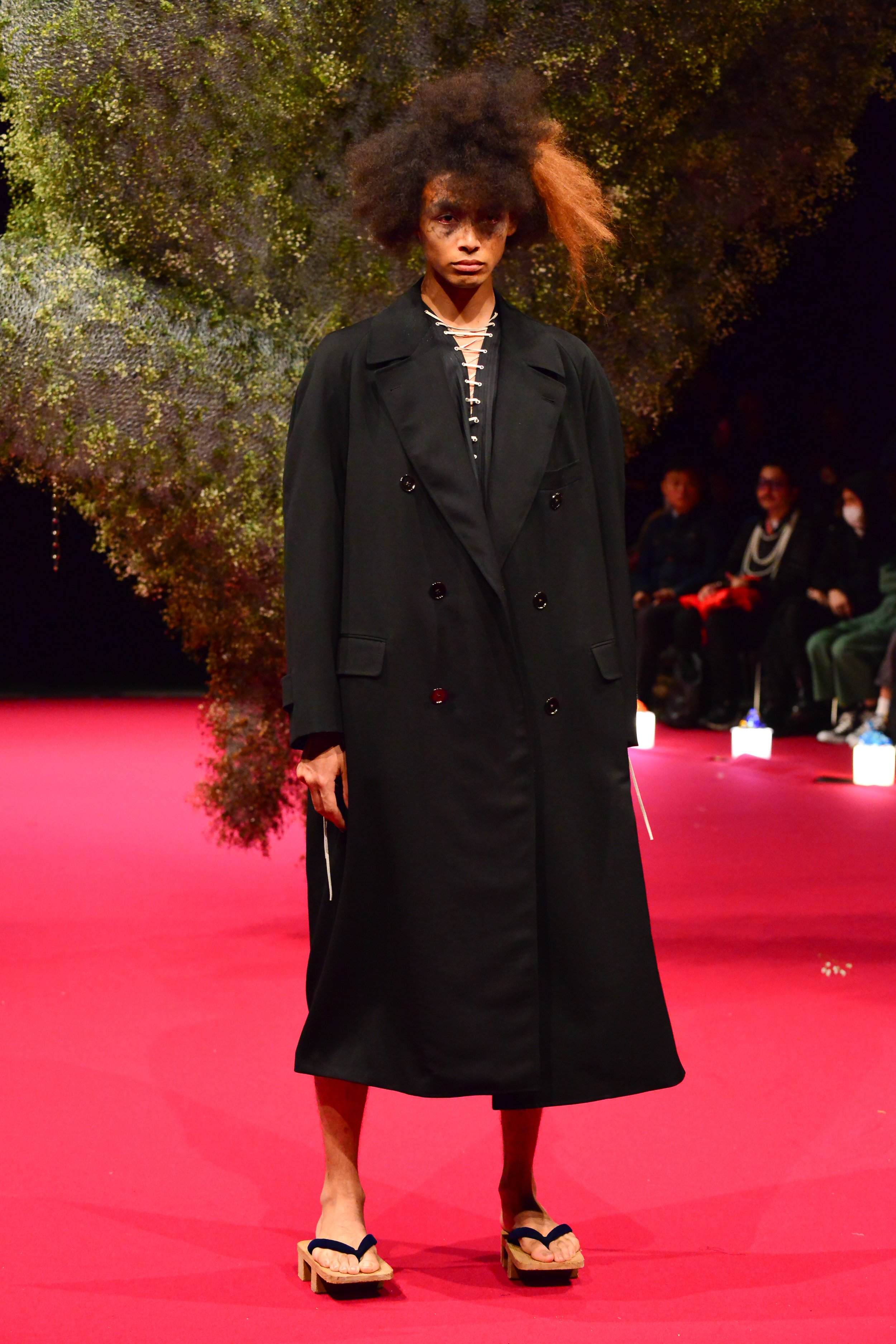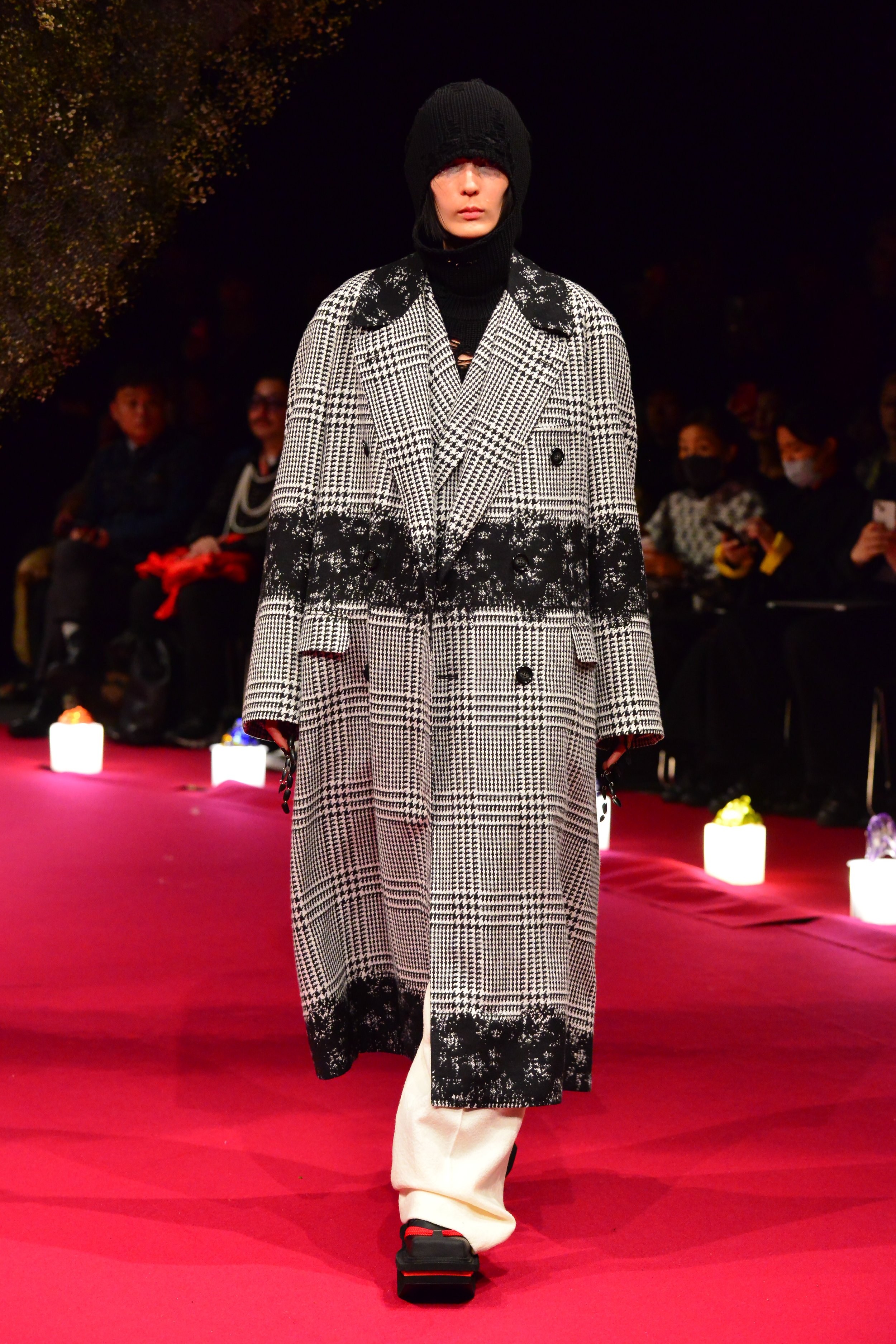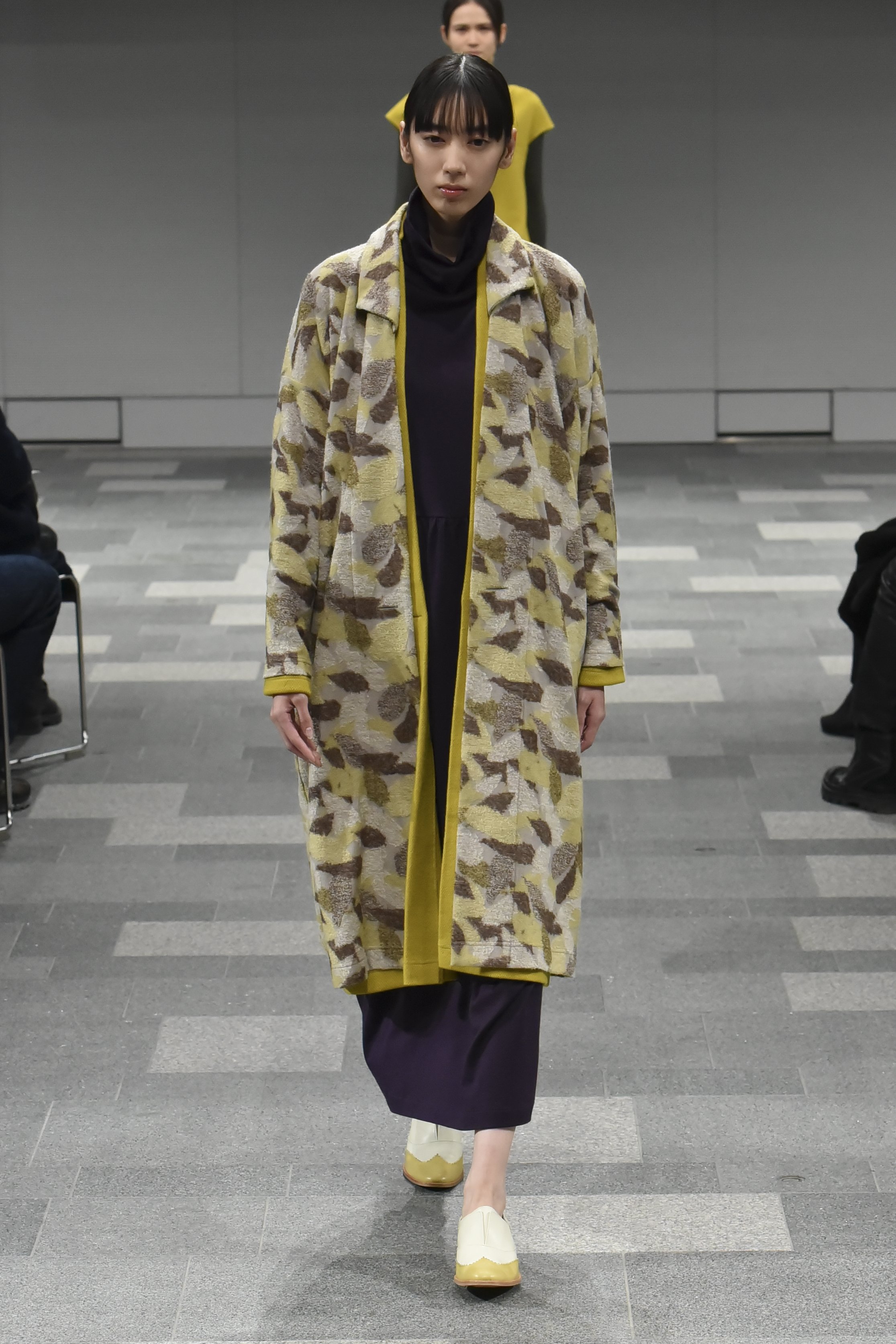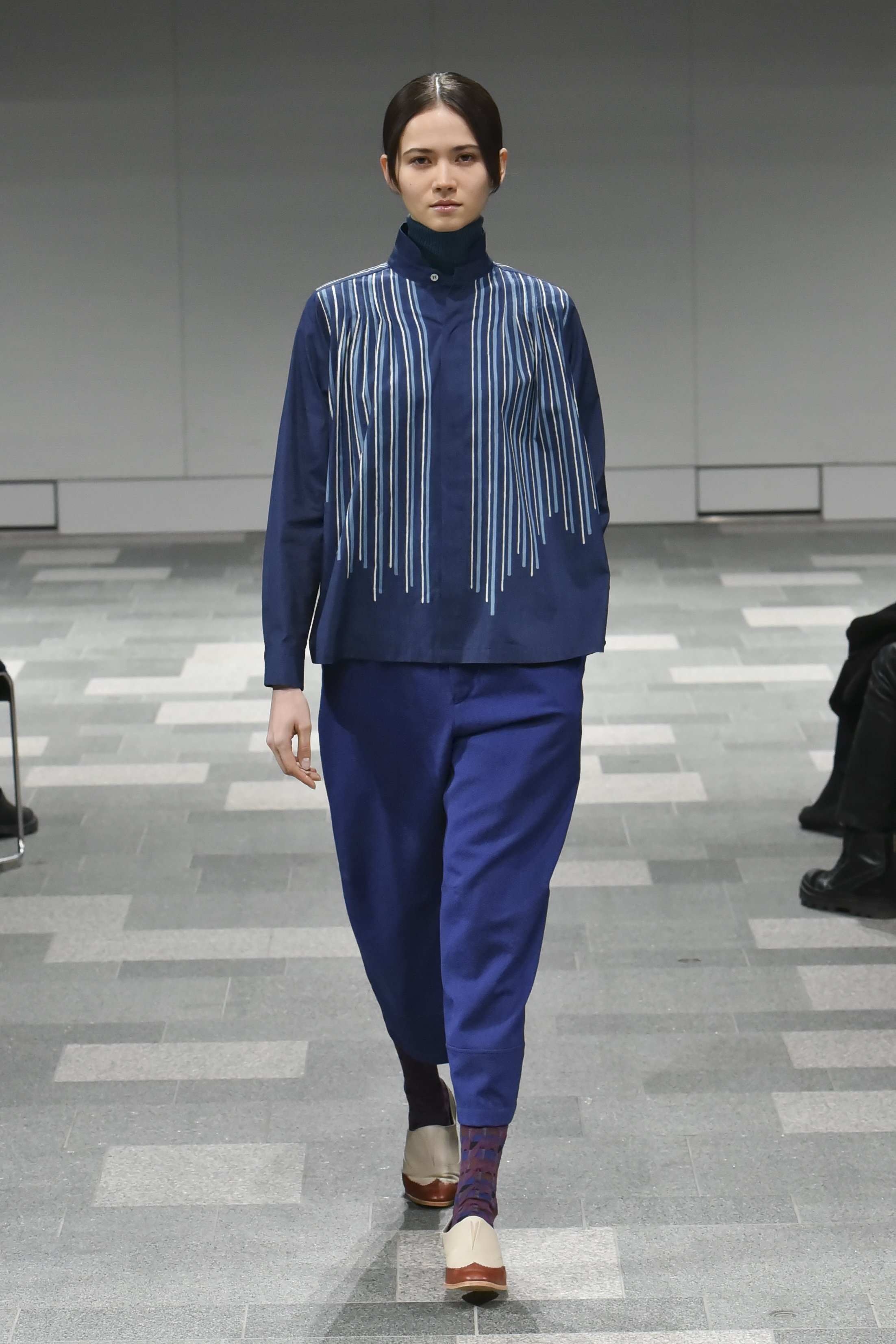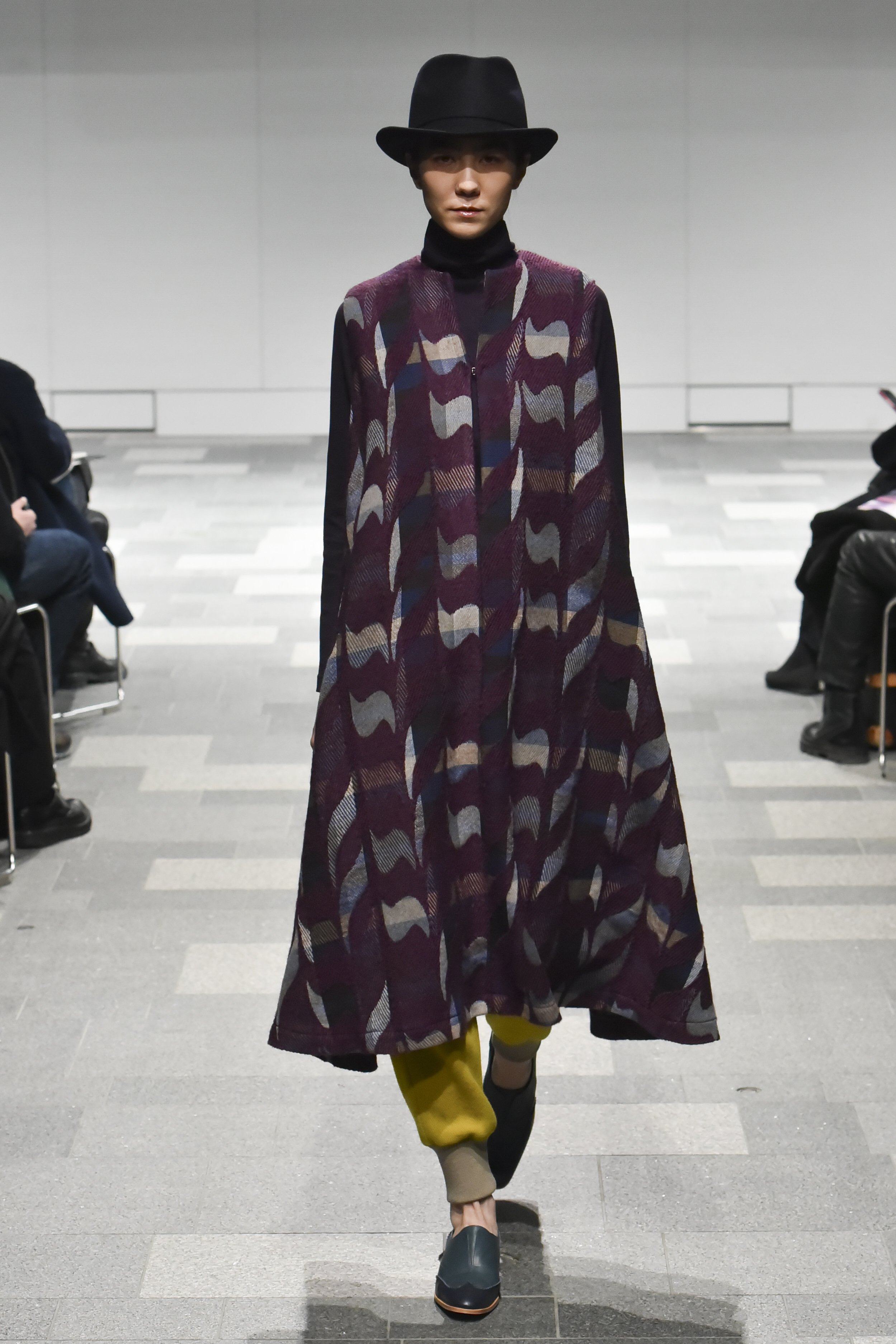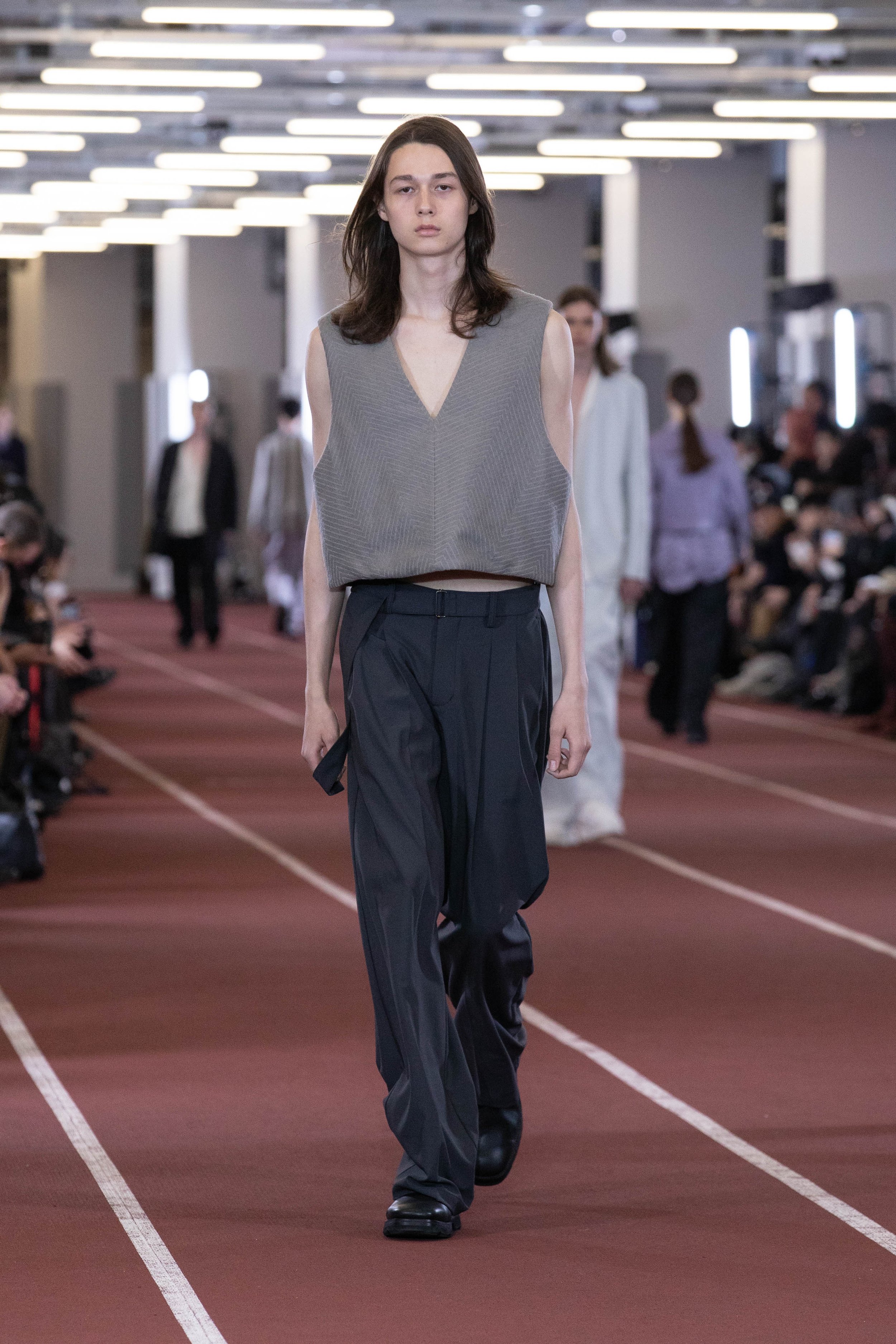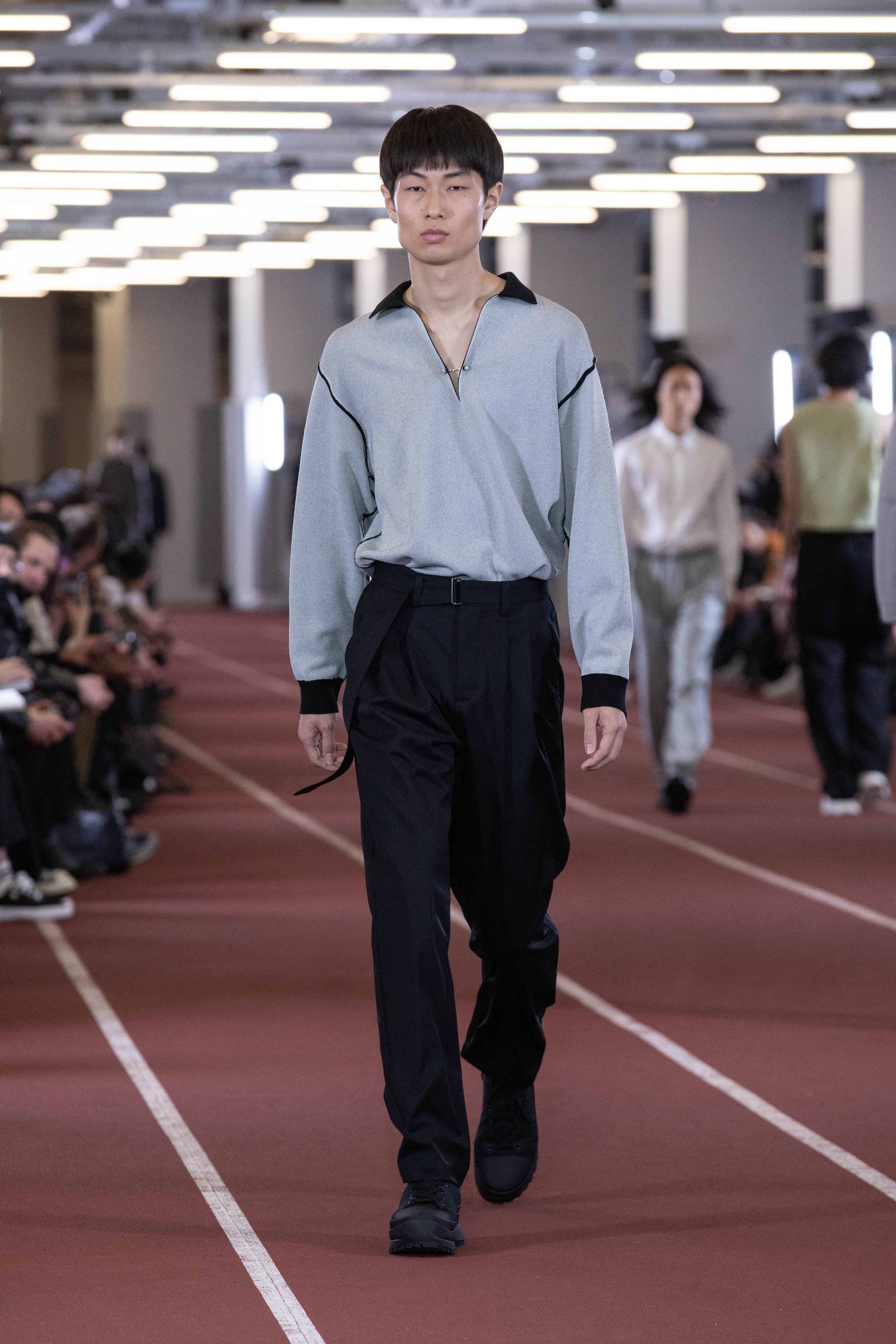Tokyo Fashion Week: Metre and Measure
As Rakuten Fashion Week veered back from the virtual onto the Shibuya streets for the first time post-pandemic – from the mallet-strike that rang in the opening ceremony – music provided the metre and measure for the many catwalk events.
By: Noah Snieckus
“DTTW correspondent Noah Snieckus was in Tokyo for Rakuten Fashion Week last month, this is his diaristic account of what went on during his time in Japan.”
Across Japan’s capital, matted to the walls of various restaurants, elevators, and — most often — trains, are signs that request ‘quiet’. Expectant hush of a near 38 million metropolitan mass, coursing in their urban journeys, seems rich. But from what I have seen in my short time bustling between the mostly flat ends of Tokyo, is that Tokyoites are less shy, an un-based assumption I had made on arrival, than they are to-themselves. Reserved to a degree where eye contact seems sometimes a bridge beyond acceptance in day-to-day societal communication. It’s bizarre how being centred within a moving crowd of 200-odd people, queued by steps towards differing destinations — without need to divulge the common, inevitable one that we share — proved to pronounce itself as such a lonesome reality. Perhaps that is because there is enough visual stimuli in sight to keep the pulsing population distracted; or maybe less voice in the air to drown out thought.
This somewhat still air travelled ten floors above one’s first steps out of the East side of Shibuya station, in the Hikarie multi-story shopping complex, at the edge of the famed neighbourhood’s high-end fashion district. Just gone noon at the opening ceremony of Rakuten’s Fashion Week, and general formalities were presented to the gathered collective of press, sponsors, models, fashionistas and other cultural cognoscenti over champagne and high-hopes for the six days ahead. A contained excitement, it must be said — if notepad and/or camera was not to hand, it was best to cuff a wrist behind your back.
All to say: at first interactions were slow, as were transitions between speakers; the space was airy, not sparsely attended; and words were few and far between. Until an older, shorter man of importance in a khaki samue appeared with several oversized mallets. The four leading organisers swiftly formed in a semi-circle for the audience to witness as they hammered down on a wooden slab enacting a tradition called Kagami-Biraki, where a sake barrel is broken into and the contents shared. At the time, this drum-hit seemed an act in favour of ribbon-cutting, given that, on the synchronised drop and the clank of that sound, music commenced and people applauded. Afterhand, neither sake nor wood splinter seemed significant, but rather the resonance of a single instrumental action. It was music that inaugurated A/W ‘23 with a primary percussive strike of wood on wood.
[Credit: D.Nart.Ampta ©JFWO]
March 13th
3PM
D.Nart.Ampta (*) @d.nart.ampta
Attendees filed-in by the dozen through the doors of the famed Omotesando Hills complex and down the mall’s marble flights to queue at the congested entrance of ‘Zone O’ for Rio Onui’s show under his label D.Nart.Ampta. Brash were the ‘fits of the few Westerners among the largely local, less vocal ticket holders. The denizens of Tokyo, layered in a more situationally prepared manner for the occasion: cow-hide leather messenger bags over a shoulder reinforced with tweed, or a buttondown with floral etching to a seam, were juxtaposed against symbols of anarchy inked on the lapels of a silver sparkled crop jacket, as worn by one American.
Doormen took several glances down at their wristwatches before the masses ambled into the room and around the red carpeted floor of the catwalk. At this stage, the second show of the week — the first in my list of invitations — the only music was composed of camera shutter sprees from the press crew to my side and the chatter of 300-odd observers taking their seats. The shadowed set was dominated by a live three-pronged tree and skirted by blackout curtains. Twenty-six pots lined in front of the first row, as I came to see when the room darkened, housed oversized plastic candles.
Tension mounted silently within the audience, mirroring orchestral strings that crescendoed to meet with barbed keys that matched each stride the opening model took in a faceless balaclava and lace-lined overcoat. A violin reappeared in the mix just before the model posed menacingly before myriad cameras. The remainder followed suit, in some cases in actual suit, with royal brass buttons or jangling gold charms. Piano keys were struck fervently to front the first run’s final set of designs: a large fedora, feather appropriately tucked to one side of a model; wooden block sandals and white gold chains dangling from the nails of another. The panache all the while found through the excess of accessories.
[Credit: D.Nart.Ampta ©JFWO]
D.Nart.Ampta provided the word “unwind” as the concept behind this season’s run when interviewed as part of their ‘newcomers’ written initiative. And it was hard to see sense in this associated theme when watching men in Georgian inspired wig-and-attire drag their feet in a loop, to a loop of stumbling minor chords. However, one might forgive or account for the set's eerie vibe, evinced by similarly-striking sound design, by applying Thomas Carlyle’s maxim of ‘music being a reflection of nature’ — “If you look deep enough you will see music; the heart of nature being everywhere music.” These two aspects, in their own right — nature at the heart, and as a reflection, of music — both reinforced the space they set out to create and blunted each other through theatrics, the set with its own muscle and muse, the sound mirroring it. Sense couldn’t be seen, until the lights faltered to just the glow of candle, emphasising the hushed voice insisting “You need to unwind”. With this came the show’s second segment, and an off-kilter trip hop instrumental that rang far more true to the intention set by the brand to relieve stress, than the former sounds projected.
Just 24 bars into the change in beat, the echoing refrain “you need to unwind” brought with it a quartet of two-piece suits sporting eccentric patterns down the catwalk, backed by a faster rhythm, an alto sax, and accompanying brass that crept up out of a fog of metallic kicks. Another shift in sound, this time without warning, featured scales that raced across a grand(-sounding) piano atop chugging drums — behind distressed sweaters with built in, open face balaclavas. But for all the talk of unwinding, both song and stance wrapped only in clockwise laps around the centrepiece, never unravelling the coil that formed and only tightened as the night went on, and as models came forth before retreating out of sight.
[Credit: SEVESKIG / (un)decided ©JFWO]
4PM
SEVESKIG / (un)decided (*) @seveskig
Across town, ten floors skyward through the labyrinth of designer PARCO boutiques, the SEVESKIG team assembled in the final moments before their rooftop runway debut at this year's Rakuten fashion week. Attendees manoeuvred around the pentagon formation of front row benches that models would soon lap, and the clouds hung low and grey. Feet shuffled along the wood-slat floor and up the raised level I and other press stood on, echoing the drums of the afro-fusion mix from the café that banked the terrace. But the musical accompaniment far more prominent to ear was a mix of EDM from Shibuya street level speakers, and the parade of planes that flew overhead.
An elderly man to my left jolted as words barked from the speakers. There was no scarcity in size of sound system clearly, and the initial scape was set to be dystopic: “War is over” the show began. “Fourth world is over, if you want. Love is over, if you want. The show must go on.” These initial words were uttered and stuttered over drum breaks in odd loops, often seen out with a cowbell twice struck.
The designs, by Takanori Nagano, were just as outlandish, and well knitted to the neo-Orwellian nightmare being churned out of megaphone quality speakers. A desert camo two-piece with accentuated shoulder panels in place of sleeves, neon details, and a bee-keeper style netted skirt of the same brown made its way forward, the music turning into the type of dubstep that works on the basis of tension and release. Many stand-alone hoods and mohair faceless balaclavas clashed purples with sand and met with enlarged anime depictions on small-collared polos. But the signature shared motif between all models were the strips of tassel that hung from at least one piece on each model as they marched past the press corps: a rope belt let loose and tailing behind like an undone apron; a feature flailing from a knitted hat; a drawstring of a hoodie. So many head-balanced ornaments and scarves that when an Aztec-clad model with a half-animal, half-alien mascot head appeared, no one looked to be fazed.
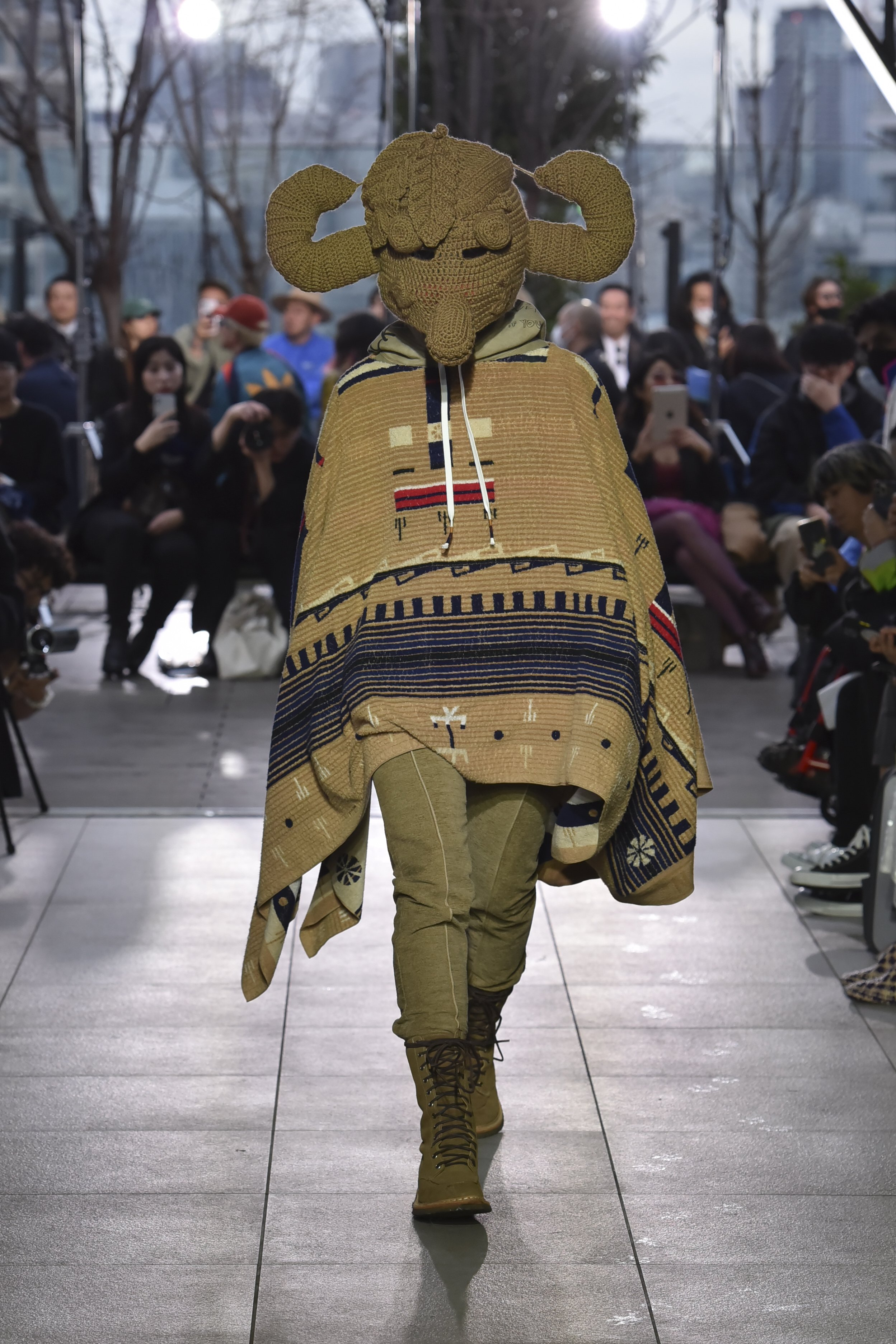
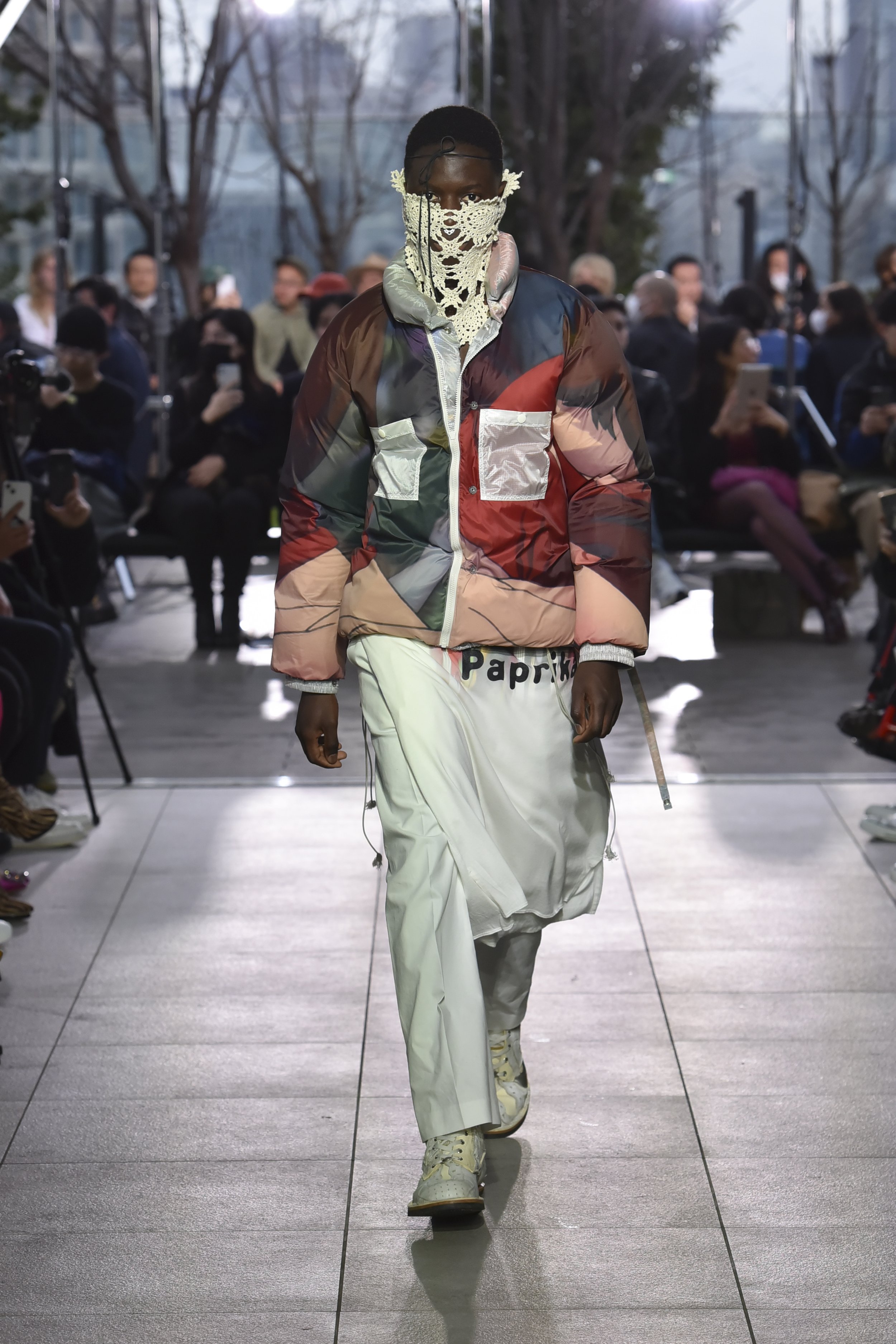
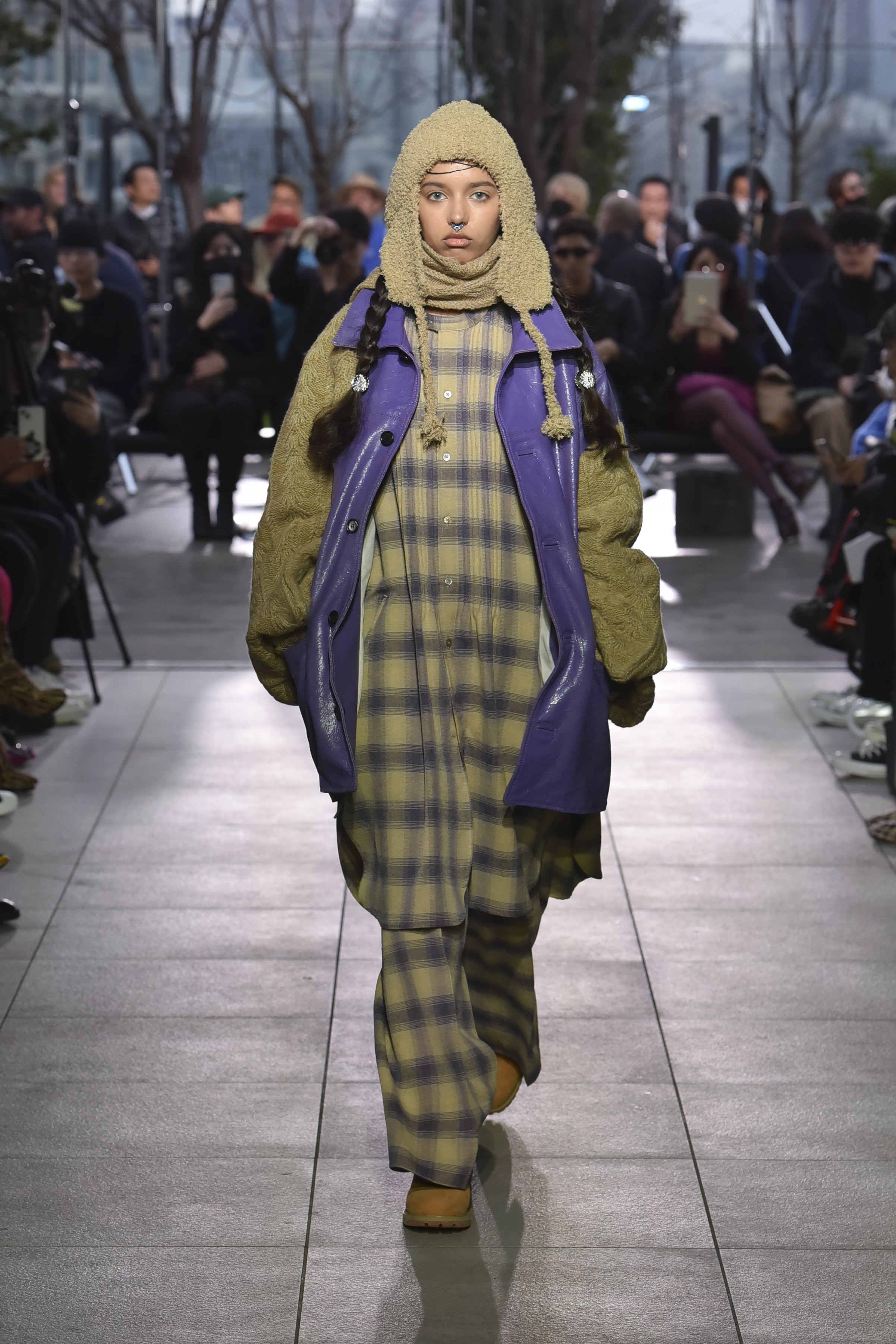
[Credit: SEVESKIG / (un)decided ©JFWO]
From a sonic compositional vantage-point, as the designers' themes intertwined with sartorial disciplines, it was interesting how, at various stages during the show, fewer models were in the runway’s loop. In the same way that veteran stage-actors know when to let silence speak for itself in the space before delivering a line, Takanori Nagano knew when to give the music air. Those in attendance were left to sit with the set and sounds, in reflection away from visual stimuli, before fashion was re-introduced in the interdisciplinary mix. In a similar manner, Francesco Risso, creative director of Marni, in conversation with Vogue earlier this year, compared his process in learning the cello to fashion in its entirety: “Making clothes is about giving life to objects “that have a harmonious, pleasant sound…[just as music can be found within] the pause and the note.” The empty space within the show held arguably as great weight alone as when it was filled with sound.
Sonic attunement seemed a clear focus of the curators of this show. So posed the ‘question’ as to whether the bleed of city sounds, even here 150 feet up in Lina Ghotmeh’s “vertical street” design building, was an aesthetic choice, given the rawness and edge of Seveskig’s fashion, or simply something that couldn’t be controlled given the space desired for showcase? Either way, it never proceeded as a distraction, though it did proceed. If anything, being centred within the cityscape, with continuous sensory reminders of such, helped fix the show within the ridgid, yet never colliding, bustle of Shibuyan chaos — an experience free of the need to block out the urban white noise.
Once again, the run ended with the same words uttered robotically from the speakers as at the start: “War is over.” This time, with further conclusiveness in the absence of “if you want.” Now a single take, diced and served in a stream of military jargon, as if clarity was found through the show, the backing instrumentation ever-mechanical. The machine ever-turning, guests made their way to ground level.
[Credit: matohu ©JFWO]
6PM
Matohu @matohu_official
Down the flights and through the doors of Zone-O, I find myself again on the lowest level of Omotesando Hills. This time, standing within one of the two horizontal lines to each wing of the space of guests, we are to watch an especially interdisciplinary fashion showcase held by Matohu’s design team. Particularly so because, a setting already structured and curated to display fashion in tangent with sonic elements, Hiroyuki Horihata and Makiko Sekiguchi have portioned their agenda to be part-documentary as preface, in which their creative – largely, textile manufacturing – process is seen through cinematics; part-catwalk for their latest designs.
The hall was arranged far differently to how D.Nart.Ampta occupied the space: an exposed floor – slabs now to be seen, carpetless as cold, grey material neither marble nor concrete; a projector and screen; and blocks of plastic chairs interlocked like a lecture hall, but for a carved path for models to wind through. A piano flexed and faltered above the movement and rang reminiscent of Bill Evans in its touch but was far too unintentional rhythmically to be Bill. By the same measure, and metre, ethereal synths were released in haunting gusts as the first two models made their way towards the walkway and, in a loop, the synths sounded as though they folded in on themselves as waves would.
Fedoras, wooden dress shoes, woven overcoats. All dyed in traditional blacks, navys, greys, there was often a single piece within the wider ‘fit composition that added volume, and perhaps eccentricity, in colour: mustard tights, a tie-dye blouse. But never more than one. All garments loose fitting and accessories propped, hung, or tied-off neatly.
[Credit: matohu ©JFWO]
Water sounds found their way subtly into the mix as the room watched, and experienced, the introduction of a handpan in sputters. Still in mind, and in line, with the lapse of waves and ethereality of the piano. Baby blue maple leafs and incomplete grids could be seen in the embroidery of yet another midnight blue overcoat. But the graduality of this change in design, from a largely minimalist palette — Parisian-inspired, reflecting the soundscape — was what was most satisfactory to those fully engaged in this show. Through this ease into a more alternative run of designs, the clothes themselves were still less intriguing than the colour choices, fit and texture, and composition: corduroy dresses, the palette of a lipstick set, met with polished olive clogs; straight silk dresses in black showing only an ankle worth of red leather trouser. The brown sherpa down jacket started to make sense in play with the purple hued, high-collared dress. There were changes, and arguably aided in keeping minds engaged and eyes on the lookout for patterns within the patterns.
A second video played once the models had given their final synched bow, video now encasing the catwalk’s contents. It featured gentle keys again in the backdrop, but with more pace and velocity. Sounds, of that sort, were set against clothes that tested the traditional colour combinations, with greater experimentation in fabric and design. Tied within a clip, in which an industrial sewing machine was paired next to the workings of hand stitching poses a cross-analysis, one could make, in standing by tradition in the midst of a new age that promotes mega-consumerism through fast-fashion. Matohu’s resistance to the modern industrialisation of textile processing, and prior handiwork in earlier stages of their manufacturing — a true transparency next to their competitors in the design world — aided their image as integral in paying homage to their heritage. Rooted in pottery, the legacy of the Sodeshi-gama kiln was visualised on-screen, weaving their slip-covered, etched ceramic buttons as leading association into the wider context of fashion. The show struggled to capture the youthful audience that was so adamantly present throughout events this week, seeking the perpetually new in an ever-evolving industry. Still, these were clothes, beautifully crafted clothes, with a lean, clean aesthetic, and a story bred in the bone of the Nana period (710-784).
Just as the piano played, once again, in a way that took steps inwards, before reverting the same steps out as a thread is double stitched in a ‘catch’ method, music, too, helped bind the many pieces of their show.
[Credit: Tender Person ©JFWO]
March 15th
12PM
TENDER PERSON (*) @tenderperson
Before the room where Tender Person was to showcase its A/W ‘23 collection had reached even a third of its standing capacity, half an hour prior to the overhead lights dimming for showtime, a near one thousand white carnations stood in line to either side of the catwalk. Spotlights, hues of lilac and white, flanked the warmer lamps, the latter reaching and assisting only a handful of flowers; the former cast across the entire space and up the walls.
Press had doubled from yesterday and made up a sort of militant mountain behind machinery and lens, mask and tripod. A single monotone synth lay the foundation for the designers, Bianca and Yashige Yuto’s chosen soundtrack, occasionally altering and becoming a noise that yearned in reverberation. Certainly, it gave the feeling of music intended to set the scene, rather than mood – though it encompassed the latter just as well.
The score wasn’t big-band or puzzle piece orchestration by any measure, but it foreshadowed potential for such development. Additional brass instrumentation crept up at irregular intervals above the tidy slew of sound. Indeed, the scene had been set, and the show looked very much to be performative. Six models, the first seen after a minute-or-so’s darkness, broken stroboscopically only by cell phone cameras, eager to capture designs take to the floor. They stood on stage in formation on differently heighted platforms as if preparing for the ensemble rendition of an orchestral piece. As if on cue, Beethoven’s Egmont" Op. 84 - Ouverture began, in all its heart-wrenching angularity, tragedy seemingly awaiting at the crest of every ascension. The lack of ease in even the most gentle passages felt the result of upturned notes as rushing runs that paid the price of impatience.
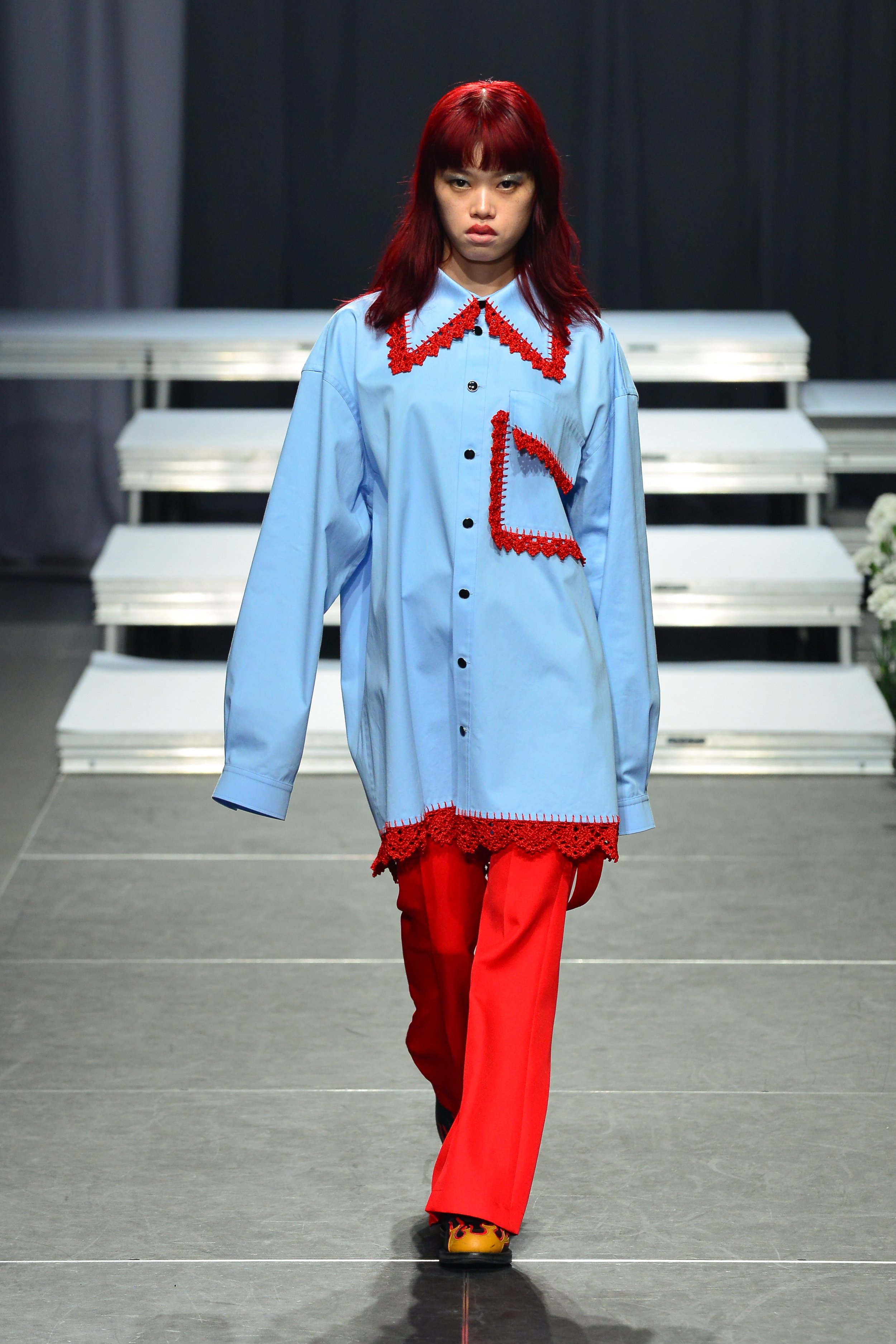
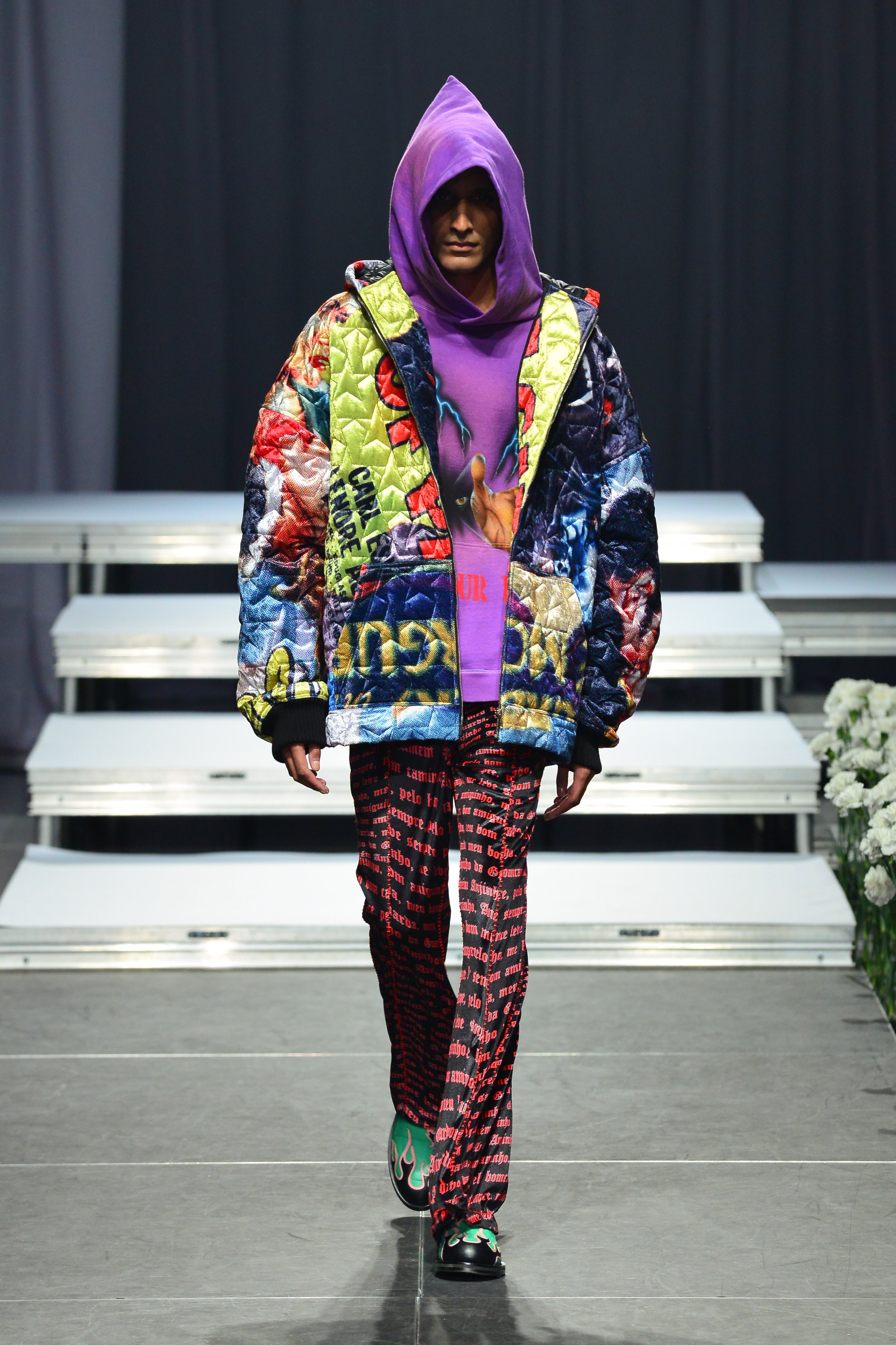
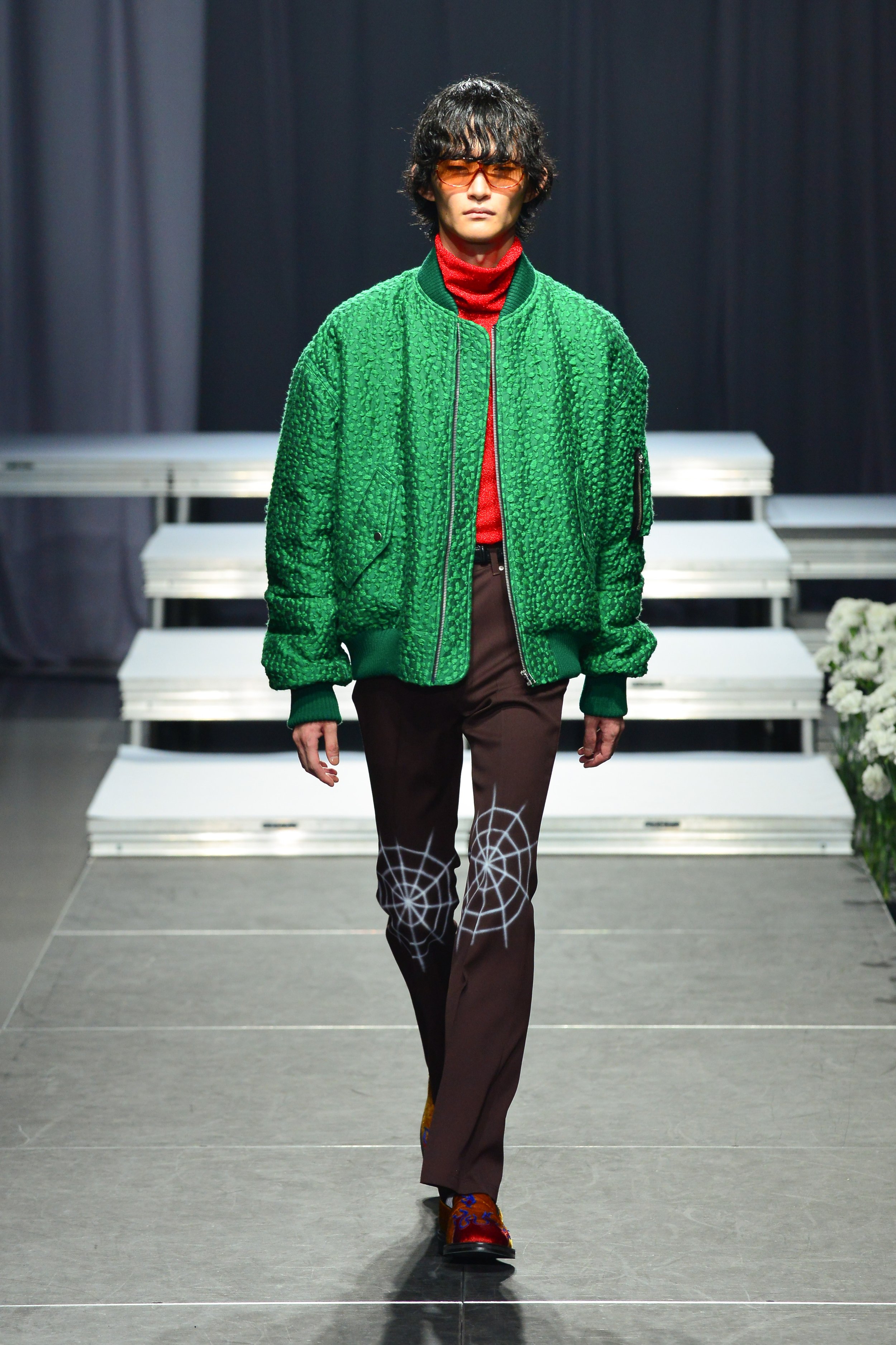
[Credit: Tender Person ©JFWO]
A linearity and colour scheme redolent of Mondrian, the first two-piece ensemble to arrive on stage, with an oversized collar and flare trousers, saw the palette bend and lose sense towards the cuffs. So finally lacked the cleanliness of the Dutch modernist, the blacks within the mix of colours bleeding and blurring lines in a scuffed hash, how a wet ink might smear from its original form. The lapels on the second suit and pocket also oozed at the seams with colour – purple against the stone-hashed jacket fabric. Lambent flames rose out of the pink sparkled bottoms of a model into their mohair sweater, posing a threat to their necktie.
Fire was the first theme. Looks inspired by Balenciaga’s 2020 catalogue — its less colourful side — Helmut Lang, Bianca Sanders, and Commes Des Garcon Homme could be cross-examined in that the cuts were conventional in the sense of inter-era stylistic cross-pollination. Through thematics, knitted and coloured in variation, Tender Person defined, and incorporated, a sense of brand identity. A number of spider web-kneed jeans, heat sensitive gloves not overreached by the overly-long sleeves, tufts and frills, and Frankensteinian features First came a graphic silk button down, then a handprint and text on a slim dinner jacket, and at a later portion of the show, in the designers themselves taking to the stage to bow at the end, Yuto, himself, in a Frankenstein green dyed-do.
The sound design found a different purpose on the tenth ensemble to touch the catwalk. As the model started off in strut – the most abstract ‘fit so far in all of its Oxford shirted, rainbow gloved chaos – the crowd was forced to feel the music. Sounds that ring and sounds that shake, as with this one as an electronic bass rattled the venue, hold a physicality that provides a much deeper experience in show. Just as, from my position stood rows behind the seated guests, the models appeared as a light beyond the dark-cast silhouettes, sound came to be the physicality beyond mere observation. One get-up: Chuck Taylors, heat-sensitive gloves, soft corduroy shorts, a flame clutch bag and a hoodie that read “close your eyes,” suggested further that this show was intended to emphasise and draw attention to the senses. Just as it was the show’s intent to draw them from attendees through fashion, through music, through printed word, as the disciplines intertwine and evoke such by nature.
A Big Bird faux-fur mink, the final piece out, sported unbuttoned and bare-chested, saw the overhead lighting follow the models footsteps out of sight, again, into darkness. Church bells rang in the Benedictine Monks’ ‘Te Deum’ that sang out as the models toured their final conjoined lap. A fitting conclusion for the overarching themes of life, flight and death. Only in this end, attendees picked up the carnations in bunches rather than putting them down, as done at a funeral. On the frontier of fusion and confusion, having attended Tender Person’s show, one would be hard-pressed in their attempts to top the summary provided in Youtube comment-form from this show’s press footage on Rakuten’s channel: “Rockabilly, hippy and cholo chican culture mixed. Bravo”.
[Credit: ATTACHMENT/VEIN © ATTACHMENT Co., Ltd.]
6PM
ATTACHMENT / VEIN (*) @attachment_official
Just North of Shibuya – twelve minutes by metro at best, fifteen today – the packed, hushed, carriage I stood in mostly emptied out at Kokuritsu-Kyogijo station as the sun set behind Japan National Stadium. Designed by Kengo Kuma, architect behind the UK’s V&A Dundee, the first design museum in Scotland, the stadium has operated as a multi-function sports arena since its reconstruction in 2019 in time to host the infamous 2020 Olympics. Able to hold some 48,000 at full capacity, the five floor, 194,000 m2 venue would be a great challenge to overlook, with its storey-high concrete support beams and shrubbery-lined balconies. Finding the entrance provided by ATTACHMENT, on the other hand, required a group of ten fashion students, equally bewildered with printed invite in hand, plus me, making several laps of the stadium in search of Gate 3, a single journey across the modern plain towards a local gymnasium that looked promising, and a security guard to provide detailed directions down flight, past mural and right…
Night had now long fallen, but it wasn’t pitch black as I was guided through the bustle beside the walkway. It was blue – electric blue. The hue you’d find stuck to the studio walls stripped with LEDs. And yet the ceiling and faces of others there seemed to retain, or gain, a ghastly paleness from the central white light. Silent hand gestures between two organisers helped guide me to my seat in the front row. I was one of the last to sit catwalk-side, the runway itself an Olympic sprint track. Sound started even before the lights switched off, but it was easier to identify its genre when they did. The music was designed by AOKI Takamasa, a straight-laced take on Japanese electronica providing the pulse for models to walk on-beat to. Initially rhythmic in its bass-led finality, that’s shiny shape and tone matched with the space fitted with metal light fixtures and piping. The room’s lighting then became brighter than day, as the first few models completed their 200 metres, exactly, the unfiltered cast beginning to warp and weave across the track.
[Credit: ATTACHMENT/VEIN © ATTACHMENT Co., Ltd.]
The designs were minimalist, colours did not clash. Greys were solely part of their wider scheme, black chore coats with beige nylon bottoms. Perhaps the most abstract piece from the first set was a knee length suit jacket, missing the collar and with a slouched shoulder. Wrinkles were a common texture, put to use within panels of cut-and-sew anoraks and button-down shirts beneath pullover vests of the same sheen.
From press pics of the event, it would seem as though the show was to be divided by section in terms of stage lighting. It streaked striking silvers and gloss-black across leather only caught on flash in darkness. But it was instead the duality provided by the altering light source that meant the garments could be seen within the context of night and day. It provided a profound and thoughtful lens to present ‘all-purpose’ garments in.
The show’s soundscape became purely electronic when the lights locked onto the track. A mid-frequency hummed in the forefront as rough synths rattled from behind in sweeping pans. The models kept whatever pace they could, still. And, coincidently, this new age sound – one that suitably mirrored the aesthetic of six-zippered fleece attire – was the preamble to even deeper cuts of ‘noise’ beyond music as it rose in an industrial rush, peaking and turning in on itself, until we were left with just the hovering hum of a helicopter.
Drums did return once again in tight-pressed rolls that stood ground before becoming loose in a conclusionary manner – the show was over.
Conclusion
The final musical accompaniment of the week finished with the yearning reflection of the existentialist in a Tony Bennet and Bill Evans duet: “I wish that we were young and foolish again.” This I found on tape, waltzing, in tune and rhythm, alongside the models clad in Mod-wear. A sentiment with eyes moored deep in the past could only be found within a setting culturally strung to tradition.
Recent Parisian fashion shows, out of a perpetual industry foresight, seemed to shun the use of Jazz, unless fused into a modern scape set to new age synths, 808 hits and/or a robot to declothe the willing models. Dior’s New York showcase last fall proved adamant that the Orchestra present could perform only with the ‘tongue’ overlays of Sheila Chandra to confuse the muse. Tokyoite designers, on the other hand, have historically resisted ‘the now’ in high-end apparel. Or at least have shown a greater affinity to former fashion in working so closely to the great successes – namely the Nigos’, Miyakes,’ Moris’ – that they haven’t been able to stand on their shoulders, a comment made in the Japan Times last September following the passings of the latter two icons. The long-posed question that then must find re-circulation within the argument for creative originality is Nina Simone’s “how can you be an artist and not reflect the times?” Is this concept entirely applicable to an endeavour that readjusts age-old trends, then reintroduces them to pop culture rapids?
Some shows during this season of Rakuten fashion week were positioned, perhaps, too far in the past to captivate excitement in this particular time and space. Old can in fact prove gold given the interplay of trend with ties to specific geographies, in their reception. Tender Person, as prime example, struck the balance between nostalgic and novel. Matohu, “wearing the transition of time”, as the design team grasped conceptually in titling their two-part documentary, grappled with time as a linear measure and consequently straddled the consistency attendees seek in forward-thinking fashion.
This, within the confines of any one designer’s sonic showcase strategy, mattered sometimes as much as the garments designed to first be pitched up and down the catwalk. So, in returning again to the question practically impossible to answer without a poll from guests in attendance – “Does anyone listen [to what they hear]?” It must now be answered alongside the purpose of accompanying sounds, gained through the methods of communication at TFW.
Music crossed over into the physical as soundtracks resonated through the industrial event spaces and became a means by which one could feel the show, and in such cases, these shows saw greater audience engagement. But if the balance wasn’t struck, where one couldn’t but listen – as was the case during Seveskig’s showcase where a press member shooting to my left practically toppled over when sound first boomed from the stacks of speakers – it lost enjoyment to imposition. Just as UCF’s sounds lacked crowd-control to sonic underwhelm.
From a macro-level, music was time throughout TFW, providing the meta-structure in which all the shows operated: a drum hit that kickstarted the opening ceremony, rolled through and kept pace with events, structuring engagement – when to dim lights, when transition thematics, when to applaud – and finally in music fading away for the final time, a timestamped finale to the week.
Down to the Wire correspondent.




